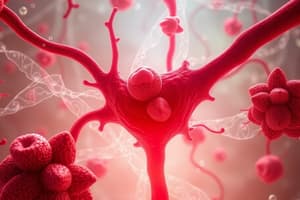Podcast
Questions and Answers
What initiates the intrinsic pathway of coagulation in haemostasis?
What initiates the intrinsic pathway of coagulation in haemostasis?
- Contact with collagen fibres (correct)
- Platelet adherence to collagen
- Release of tissue factor
- Formation of a platelet plug
During primary haemostasis, what role do platelets play in the formation of a platelet plug?
During primary haemostasis, what role do platelets play in the formation of a platelet plug?
- They stabilize the clot through the release of thrombin.
- They convert fibrinogen to fibrin.
- They release serotonin and thromboxanes to constrict blood vessels.
- They attract additional platelets through the release of ADP. (correct)
Which factor is directly activated by tissue factor in the extrinsic pathway?
Which factor is directly activated by tissue factor in the extrinsic pathway?
- Factor XII
- Factor II
- Factor X
- Factor VII (correct)
What is the function of von Willebrand factor in primary haemostasis?
What is the function of von Willebrand factor in primary haemostasis?
What occurs during secondary haemostasis?
What occurs during secondary haemostasis?
Which factor is involved in the initiation of the intrinsic pathway?
Which factor is involved in the initiation of the intrinsic pathway?
What is the primary purpose of vasoconstriction during primary haemostasis?
What is the primary purpose of vasoconstriction during primary haemostasis?
Which component is necessary for the conversion of soluble fibrinogen to fibrin?
Which component is necessary for the conversion of soluble fibrinogen to fibrin?
What additional substance besides ADP can platelets release to assist in the aggregation of other platelets?
What additional substance besides ADP can platelets release to assist in the aggregation of other platelets?
What is the first step that occurs when a blood vessel is damaged?
What is the first step that occurs when a blood vessel is damaged?
What substance is converted to thrombin during the common coagulation pathway?
What substance is converted to thrombin during the common coagulation pathway?
Which vitamin is essential for the formation of clotting factors in the liver?
Which vitamin is essential for the formation of clotting factors in the liver?
What is the primary role of thrombin in the coagulation process?
What is the primary role of thrombin in the coagulation process?
What process pulls the edges of the damaged vessel together, reducing blood loss?
What process pulls the edges of the damaged vessel together, reducing blood loss?
Which of the following conditions can prolong bleeding time?
Which of the following conditions can prolong bleeding time?
What is th primary initial event in the process of thrombosis?
What is th primary initial event in the process of thrombosis?
What is the time range for a normal bleeding time, indicating primary hemostasis?
What is the time range for a normal bleeding time, indicating primary hemostasis?
Which of these factors plays a role in clot breakdown?
Which of these factors plays a role in clot breakdown?
Which factor is primarily responsible for stabilizing clots?
Which factor is primarily responsible for stabilizing clots?
What occurs during clot retraction within 24 hours post-injury?
What occurs during clot retraction within 24 hours post-injury?
Flashcards
Haemostasis
Haemostasis
The process by which bleeding stops when a blood vessel is damaged.
Primary Haemostasis: Vasoconstriction
Primary Haemostasis: Vasoconstriction
The initial stage of haemostasis where blood vessels constrict to reduce blood flow.
Platelets
Platelets
Small, cell-like fragments in blood that stick to the damaged vessel wall and release chemicals to initiate clotting.
Serotonin (5-HT)
Serotonin (5-HT)
Signup and view all the flashcards
Platelet Plug
Platelet Plug
Signup and view all the flashcards
Secondary Haemostasis: Coagulation
Secondary Haemostasis: Coagulation
Signup and view all the flashcards
Fibrinogen
Fibrinogen
Signup and view all the flashcards
Clotting Cascade
Clotting Cascade
Signup and view all the flashcards
Extrinsic Pathway
Extrinsic Pathway
Signup and view all the flashcards
Intrinsic Pathway
Intrinsic Pathway
Signup and view all the flashcards
What is haemostasis?
What is haemostasis?
Signup and view all the flashcards
What is the common pathway in haemostasis?
What is the common pathway in haemostasis?
Signup and view all the flashcards
What are coagulation factors?
What are coagulation factors?
Signup and view all the flashcards
What is the role of Vitamin K in haemostasis?
What is the role of Vitamin K in haemostasis?
Signup and view all the flashcards
What is clot retraction?
What is clot retraction?
Signup and view all the flashcards
What is fibrinolysis?
What is fibrinolysis?
Signup and view all the flashcards
What is thrombosis?
What is thrombosis?
Signup and view all the flashcards
What is bleeding time?
What is bleeding time?
Signup and view all the flashcards
What is the expected bleeding time after a dental procedure?
What is the expected bleeding time after a dental procedure?
Signup and view all the flashcards
What is the relevance of haemostasis to the dental hygienist/therapist?
What is the relevance of haemostasis to the dental hygienist/therapist?
Signup and view all the flashcards
Study Notes
Haemostasis and Clot Formation
- Haemostasis is the process that stops bleeding after damage to blood vessels. It involves several overlapping steps.
- Primary Haemostasis:
- Vasoconstriction: Damaged blood vessels constrict to immediately reduce blood flow. Platelets adhere to the damaged vessel wall and release substances like serotonin and thromboxanes which further constrict vessels.
- Platelet Plug: Platelets clump together at the site of damage, forming a plug. Von Willebrand factor stabilizes the plug. Platelets release ADP which attracts more platelets.
- Secondary Haemostasis (Coagulation):
- This process stabilizes the platelet plug.
- Clotting Cascade: A complex series of reactions that lead to the formation of fibrin, an insoluble protein that forms a mesh.
- Extrinsic Pathway: Triggered by tissue factor (released by damaged endothelial cells), activating factors VII, X, and eventually the common pathway.
- Intrinsic Pathway: Triggered by exposed collagen in the damaged vessel wall, involving activation of factor XII, ultimately leading to the common pathway.
- Common Pathway: Prothrombin is converted to thrombin. Thrombin converts fibrinogen to fibrin forming the mesh. Factor XIII strengthens the fibrin mesh.
- Coagulation Factors:
- Most are synthesized by the liver.
- Vitamin K is essential for the liver's production of some clotting factors.
- Clot Retraction:
- Activated platelets contract, pulling the fibrin threads together, shrinking the clot, and expelling serum.
- Clot Breakdown (Fibrinolysis):
- Plasminogen, trapped in the clot, converts to plasmin that breaks down fibrin. TAFI is a fibrinolysis inhibitor, stabilizing the clot
- Relevance to Dental Professionals:
- Dental procedures can cause haemorrhage.
- Bleeding should naturally stop within 4-10 minutes. Prolonged bleeding from dental procedures could indicate problems with clotting, necessitating additional assessment and management.
Studying That Suits You
Use AI to generate personalized quizzes and flashcards to suit your learning preferences.




